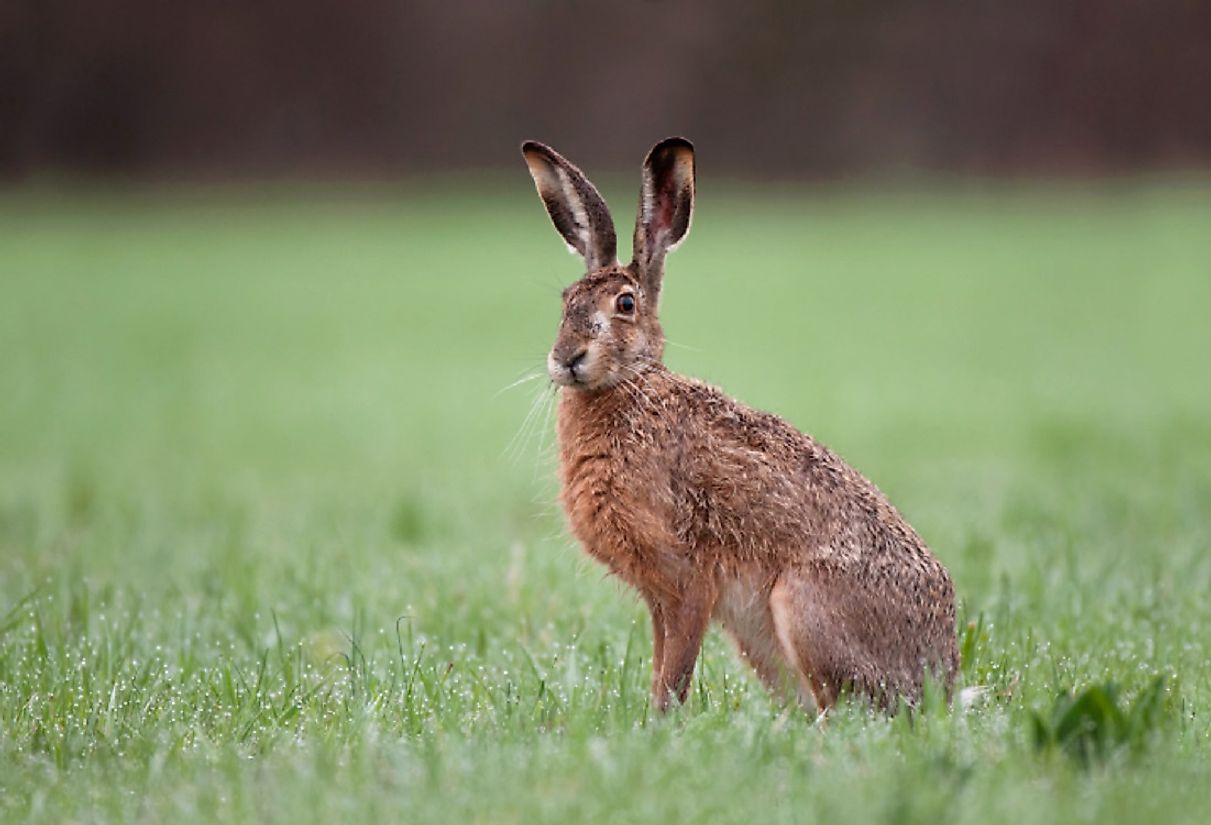European Hare Facts: Animals of Europe

5. Physical Description
The European hare's, or brown hare’s, fur coat is brown-russet, and its underside is white. It resembles a rabbit, but has a larger body, longer hind legs, and longer, black-tipped ears. Its adult length from its head to its rump is between 52 and 59.5 centimeters, according to ARKive Initiative. The European hare’s 8- to 12-centimeter tail is black on its upper surface, and white underneath. On average, a mature European hare weighs 3 to 4 kilograms, according to the Mammal Society (MS). These hares' irises are golden, and their pupils black.
4. Diet
As an herbivore, the European hare grazes on young grass shoots, herbs, and agricultural crops. It also nibbles on the bark of young trees and bushes, according to the Wildlife Trusts. In the winter period, the European hare feeds on twigs, buds, shrub bark, small trees, and young fruit tree bark, according to Animal Diversity (AD). Since its nocturnal, it primarily feeds at night. During feeding, two to three adults can eat as much vegetation as one sheep. The European hare re-ingests its green, soft fecal pellets, a practice called coprophagia, in efforts to maximize nutrient extraction from their diets.
3. Habitat and Range
The European hare is native to Great Britain and Central and Western Europe. It’s also found in parts of the Middle East and Central Asia. Within these territories, it inhabits agricultural cropland or grasslands in temperate and open habitats, as well as in pastures bordered by hedgerows and woodlots, according to Animal Diversity. The International Union for Conservation of Nature's (IUCN's) 2008 Red List of Threatened Species classified the European Hare as a species of "Least Concern" among. Nonetheless, its population is in decline in certain areas due to poaching, intensification of commercial agriculture within their habitats, diseases such as the European hare syndrome and Tularaemia, and changes in cropping regimes which affect their food sources.
2. Behavior
Since it is a nocturnal animal, the European hare feeds at night. During the day, it spends its time in a small depression it digs in the ground within long grass, and these are referred to as "form". European hares are also generally solitary, except for when they come together for mating. Still, there are certain instances when European hares may band together in clusters when feeding, according to the Mammal Society. To evade predators like foxes, coyotes, owls, wildcats or hawks, the European hare relies on its sharp senses. If threatened, these animals will usually opt to run away, sometimes achieving speeds of up to 70 kilometers an hour (43 miles per hour). Though the European hare is usually quiet, it occasionally makes low grunts, as well as shrills when caught or injured, according to Animal Diversity.
1. Reproduction
Sexual maturity for the European hare is acheived between 8 months and a year in age, according to AD, and breeding occurs from February to September. Before a female consents to mating with a male, she resists interested males by boxing them. After mating, the gestation period is about 42 days, after which time a female gives birth to a litter of around 3 to 5 offspring on average. The young ones (leverets) are born fully furred, and with their eyes open. For the first 4 weeks of their lives they are fed by their mother, and then are weaned and start eating solid. Nursing takes place at sunset in an effort to avoid attracting predators. The average lifespan of a European hare in the wild is 3 to 4 years.







